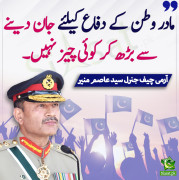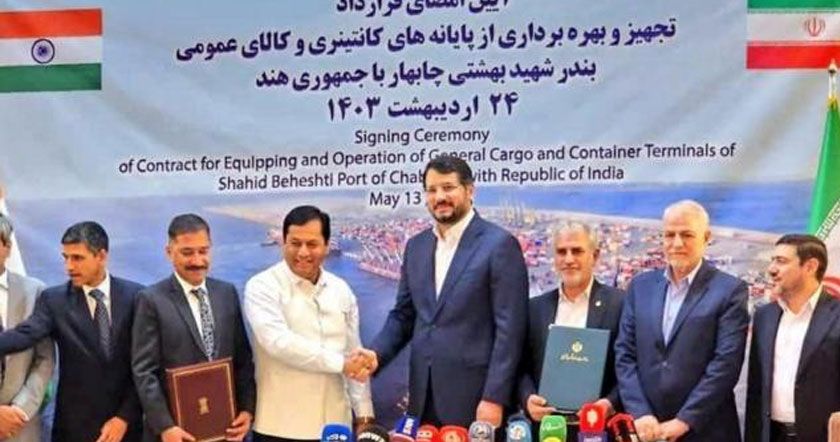NOTE: THIS ARTICLE IS A FEW YEARS OLD, PUBLISHED IN MID 2000'S
NEW DELHI - It may be fashionable to criticize America for it unilateralist approach toward the global polity, but one aspect remains unchanged - the aspiration to become a bona fide American citizen. For long, Indians, as also people of other nations, have sought out America by any means - H1-B visas for skilled workers, illegal immigrants, green card holders and menial semi-skilled hands at work. There is one more vista - through the American army.
With the US engaged in wars in two regions of the world - Afghanistan where the hunt for Osama and his ilk continues, and Iraq - the drive to enlist recruits is at an all time high. At one level, the route through the army is also very difficult and often a tragic way to become an American citizen, given the high casualties of war, especially in Iraq.
After the US launched the "war on terrorism", US President George W Bush made it easier for foreign-born US residents joining the military to gain full citizenship. Among other aspects, the usual five-year waiting period has been eased by a July 2002 executive order. Petition and fingerprinting fees were waived for service members. Any legal resident who enlists in the military can immediately petition for citizenship, rather than wait the five years required for civilians to start the process.
According to reports, of the 15,000 new US citizens who were naturalized in the week of July 4, hundreds were from the military. Foreign legal residents make up 2% to 3% of the US military, but they are becoming citizens in record numbers. The largest number of foreigners in the US forces is from the Philippines (25 %). According to the Migration Policy Institute, 410 Indians were actively serving the US military in the year 2004.
USA Today newspaper, in a recent report, said that citizenship applications from service members more than doubled in one year to almost 10,000 after Bush's executive order in 2002. In the first three quarters of the current fiscal year, the immigration service has received more than 11,000 naturalization petitions from soldiers, sailors, Marines and airmen. In fiscal 2004, 7,627 alien soldiers, sailors, airmen and Marines took the oath of allegiance. That's nearly 15 times as many as the 518 who became citizens in 2000, according to US Citizenship and Immigration Services. In the first three-quarters of the current fiscal year, 3,397 service members have been naturalized.
The report adds, "As a nation at war struggles to fill its armed ranks with volunteers, the United States is doing what it has done in every major conflict since the Civil War: it is making it easier for legal resident aliens to become US citizens if they choose to fight."
According to US immigration figures, 73 non-citizens serving in the US armed forces have died in the conflicts in Iraq and Afghanistan. Since September 11, 59 posthumous citizenships have been given out. Among them is US Army private Uday Singh, 21, from Chandigarh (a north Indian city known for its laid-back yet modern lifestyle) who was killed in Iraq in December 2004. His cremation in Chandigarh was attended by the head of the US Pacific Command and his remains interred in Arlington, Virginia. Singh, who was eager to become a US citizen, wrote to a close relative from Iraq last November. "I got some more good news. My citizenship process has finally gone through."
The carrot of citizenship through the army, of course, is a response to the US administration coming under increasing pressure over rising casualties in Iraq. With nations around the world, including India, refusing to officially deploy troops in Iraq, various methods have come to light that encourage people to join the war effort.
Mercenaries make up the second-largest occupation force in Iraq, outnumbering even the biggest US ally, Britain. A recent report by a news agency pegged the number of personnel from private military firms at more than 15,000 in Iraq. The role of civil contractors caught attention when four Blackwater USA employees were ambushed earlier in the year at Fallujah. Enlistment of Iraqi policemen, mostly Shi'ites, is at an all-time high to reduce US casualties, with the strategy to ensure that US soldiers remain safe within heavily guarded areas.
The US had made several attempts to cajole other nations to join in the troop deployment in Iraq, without much success, with the London blasts effectively putting to rest any further hopes. Among the strong-arm tactics of the past include pegging construction contracts (estimated at over US$100 billion) in Iraq to troop deployment. In December 2003, the US barred Indian companies from bidding for a primary share of Iraq reconstruction contracts. Other countries blocked from bidding for main contracts included France, Germany, Russia and Canada, all of whom have opposed the US-led war against Iraq and refused to send troops.
India has been tough about the involvement of its citizens in Iraq. In April 2004, the Indian government for security reasons banned workers from going to Iraq, but it seemed that the government, as well as US authorities, were prepared to turn a blind eye to the illegal transit of Indians through Kuwait or Jordan on their way to Iraq.
However, matters changed quickly when in August last year three Indian truck drivers illegally operating in Iraq were kidnapped for ransom and were released only after protracted negotiations with New Delhi. After the episode, the government issued instructions to crack down on recruiting agencies that were sending Indian workers, whether ex-servicemen, drivers, cooks or menial hands, to aid the US troops.
The Middle East has been a particular attraction to Indians for a long time. About 1.3 million Indians work in Saudi Arabia and 100,000 in Kuwait, while some 3 million Indians are said to be working in the Gulf region, contributing to the bulk of foreign-money transactions in the form of inward remittances. Thousands have returned to India because of instability in the region.
The desperation to move to the West at any cost can be gauged from the enormous illegal immigration consultancy machinery that flourishes across the country, particularly in north Indian states such as Punjab and Haryana. It is estimated that 300 agencies - legal and illegal - are situated in the populous and affluent Chandigarh-Panchkula-Mohali belt alone, in Punjab. Worldwide, World Bank estimates put illegal migrants to the US and Europe at half a million each.
Legal migration of workers, however, has benefited developed societies such as the US and Canada. According to one study, these societies would have struggled had there been no influx of highly skilled technical graduates, in the form of software engineers, nurses, doctors and others such as electricians, drivers, domestic workers at the low-end of the job market.
The US, hemmed by the casualties in Iraq, has offered one more avenue to ease the pressure, its own as well as foreign residents who join the war effort. The price in many cases, though, could be very high.
Source:http://www.atimes.com/atimes/South_Asia/GG30Df03.html
NEW DELHI - It may be fashionable to criticize America for it unilateralist approach toward the global polity, but one aspect remains unchanged - the aspiration to become a bona fide American citizen. For long, Indians, as also people of other nations, have sought out America by any means - H1-B visas for skilled workers, illegal immigrants, green card holders and menial semi-skilled hands at work. There is one more vista - through the American army.
With the US engaged in wars in two regions of the world - Afghanistan where the hunt for Osama and his ilk continues, and Iraq - the drive to enlist recruits is at an all time high. At one level, the route through the army is also very difficult and often a tragic way to become an American citizen, given the high casualties of war, especially in Iraq.
After the US launched the "war on terrorism", US President George W Bush made it easier for foreign-born US residents joining the military to gain full citizenship. Among other aspects, the usual five-year waiting period has been eased by a July 2002 executive order. Petition and fingerprinting fees were waived for service members. Any legal resident who enlists in the military can immediately petition for citizenship, rather than wait the five years required for civilians to start the process.
According to reports, of the 15,000 new US citizens who were naturalized in the week of July 4, hundreds were from the military. Foreign legal residents make up 2% to 3% of the US military, but they are becoming citizens in record numbers. The largest number of foreigners in the US forces is from the Philippines (25 %). According to the Migration Policy Institute, 410 Indians were actively serving the US military in the year 2004.
USA Today newspaper, in a recent report, said that citizenship applications from service members more than doubled in one year to almost 10,000 after Bush's executive order in 2002. In the first three quarters of the current fiscal year, the immigration service has received more than 11,000 naturalization petitions from soldiers, sailors, Marines and airmen. In fiscal 2004, 7,627 alien soldiers, sailors, airmen and Marines took the oath of allegiance. That's nearly 15 times as many as the 518 who became citizens in 2000, according to US Citizenship and Immigration Services. In the first three-quarters of the current fiscal year, 3,397 service members have been naturalized.
The report adds, "As a nation at war struggles to fill its armed ranks with volunteers, the United States is doing what it has done in every major conflict since the Civil War: it is making it easier for legal resident aliens to become US citizens if they choose to fight."
According to US immigration figures, 73 non-citizens serving in the US armed forces have died in the conflicts in Iraq and Afghanistan. Since September 11, 59 posthumous citizenships have been given out. Among them is US Army private Uday Singh, 21, from Chandigarh (a north Indian city known for its laid-back yet modern lifestyle) who was killed in Iraq in December 2004. His cremation in Chandigarh was attended by the head of the US Pacific Command and his remains interred in Arlington, Virginia. Singh, who was eager to become a US citizen, wrote to a close relative from Iraq last November. "I got some more good news. My citizenship process has finally gone through."
The carrot of citizenship through the army, of course, is a response to the US administration coming under increasing pressure over rising casualties in Iraq. With nations around the world, including India, refusing to officially deploy troops in Iraq, various methods have come to light that encourage people to join the war effort.
Mercenaries make up the second-largest occupation force in Iraq, outnumbering even the biggest US ally, Britain. A recent report by a news agency pegged the number of personnel from private military firms at more than 15,000 in Iraq. The role of civil contractors caught attention when four Blackwater USA employees were ambushed earlier in the year at Fallujah. Enlistment of Iraqi policemen, mostly Shi'ites, is at an all-time high to reduce US casualties, with the strategy to ensure that US soldiers remain safe within heavily guarded areas.
The US had made several attempts to cajole other nations to join in the troop deployment in Iraq, without much success, with the London blasts effectively putting to rest any further hopes. Among the strong-arm tactics of the past include pegging construction contracts (estimated at over US$100 billion) in Iraq to troop deployment. In December 2003, the US barred Indian companies from bidding for a primary share of Iraq reconstruction contracts. Other countries blocked from bidding for main contracts included France, Germany, Russia and Canada, all of whom have opposed the US-led war against Iraq and refused to send troops.
India has been tough about the involvement of its citizens in Iraq. In April 2004, the Indian government for security reasons banned workers from going to Iraq, but it seemed that the government, as well as US authorities, were prepared to turn a blind eye to the illegal transit of Indians through Kuwait or Jordan on their way to Iraq.
However, matters changed quickly when in August last year three Indian truck drivers illegally operating in Iraq were kidnapped for ransom and were released only after protracted negotiations with New Delhi. After the episode, the government issued instructions to crack down on recruiting agencies that were sending Indian workers, whether ex-servicemen, drivers, cooks or menial hands, to aid the US troops.
The Middle East has been a particular attraction to Indians for a long time. About 1.3 million Indians work in Saudi Arabia and 100,000 in Kuwait, while some 3 million Indians are said to be working in the Gulf region, contributing to the bulk of foreign-money transactions in the form of inward remittances. Thousands have returned to India because of instability in the region.
The desperation to move to the West at any cost can be gauged from the enormous illegal immigration consultancy machinery that flourishes across the country, particularly in north Indian states such as Punjab and Haryana. It is estimated that 300 agencies - legal and illegal - are situated in the populous and affluent Chandigarh-Panchkula-Mohali belt alone, in Punjab. Worldwide, World Bank estimates put illegal migrants to the US and Europe at half a million each.
Legal migration of workers, however, has benefited developed societies such as the US and Canada. According to one study, these societies would have struggled had there been no influx of highly skilled technical graduates, in the form of software engineers, nurses, doctors and others such as electricians, drivers, domestic workers at the low-end of the job market.
The US, hemmed by the casualties in Iraq, has offered one more avenue to ease the pressure, its own as well as foreign residents who join the war effort. The price in many cases, though, could be very high.
Source:http://www.atimes.com/atimes/South_Asia/GG30Df03.html










































